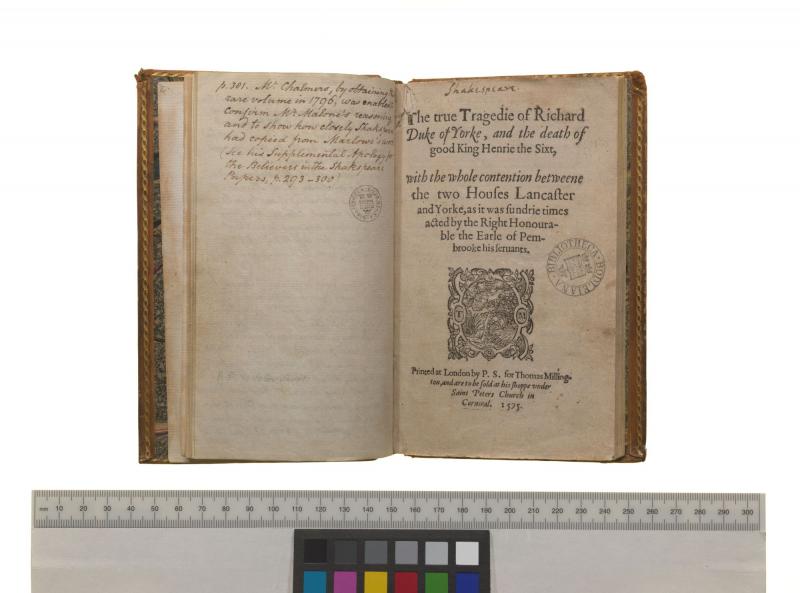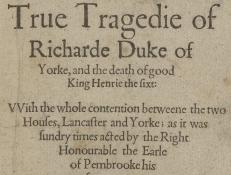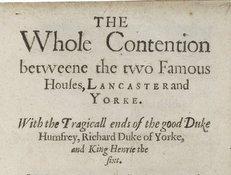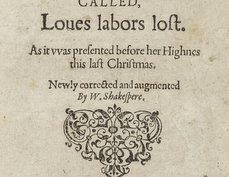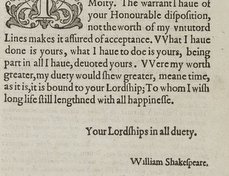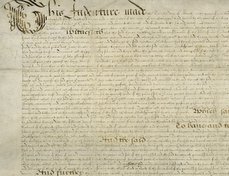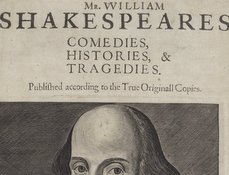Terms of use
The Bodleian Libraries, University of Oxford, has graciously contributed images of materials in its collections to Shakespeare Documented under the terms of a Creative Commons Attribution-NonCommercial 4.0 International licence. Images used within the scope of these terms should cite the Bodleian Libraries as the source. For any use outside the scope of these terms, visitors should contact Bodleian Libraries Imaging Services at imaging@bodleian.ox.ac.uk.
Copy-specific information
Creator: William Shakespeare
Title: The true tragedie of Richard duke of Yorke, and the death of good king Henrie the sixt, with the whole contention betweene the two houses Lancaster and Yorke, as it was sundrie times acted by the earle of Pembrooke his seruants.
Date: Lond. P.S. for T. Millington, 1595
Repository: Bodleian Library, Oxford University, Oxford, UK
Call number and opening: Arch.G f.1, title page
View online bibliographic record
Matthew Vadnais, "Henry VI Part 3, first edition," Shakespeare Documented, https://doi.org/10.37078/660.
Bodleian Library, Arch.G f.1, title page. See Shakespeare Documented, https://doi.org/10.37078/660.
This is the only surviving copy of the first edition of Henry VI Part 3, printed anonymously in 1595 printing as The True Tragedy of Richard, Duke of York. The True Tragedy first appeared in the Stationers’ Register seven years after this printing on April 19, 1602 when Thomas Millington transferred “The First and Second parte of henry the vjt ii books” to Thomas Pavier.
Although this play is now printed as the final installment of the Henry VI trilogy, Henry VI was originally considered a two-part play comprised of The First Part of the Contention (1594) and this text as the conclusion. In fact, the two plays were collected and printed in 1619 as The Whole Contention, but Henry VI Part 1 and the contemporary trilogy arrangement did not appear in print until the 1623 First Folio, where this play appeared titled as The Third Part of Henry the Sixt for the first time.
This edition is the only surviving Shakespearean play printed in an octavo from his lifetime. Octavo is a smaller format than quarto, as sheets are folded three times instead of twice after printing, creating eight pages.
One of Shakespeare’s earliest plays to be written, performed, and printed, The True Tragedy has long been the source of scholarly debate. Differences between this 1595 quarto and the much longer version printed in the First Folio suggest that the quarto is either the result of memorial reconstruction, or it represents an earlier corrupted, abridged, or otherwise altered version derived from the First Folio version.
According to this copy’s title page, which does not include an authorial attribution, the Earl of Pembroke’s Men, a short-lived touring company, performed the play. Although the Pembroke’s Men performed Shakespeare’s first three printed plays, the playwright himself was probably not a member. Recent criticism suggests that the lack of support for Pembroke’s Men as Shakespeare’s pre-1594 professional affiliation can be partially understood as lasting scholarly legacy regarding “bad quartos.” Earlier scholarly dismissal of “bad quartos” continues to undermine the importance of the title page claims, such as on this octavo. In general this edition, like the 1594 first quarto edition of Henry VI Part 2 counterpart, is most frequently understood in relation to the First Folio text.
In contrast to The First Part of the Contention, most critics who dissent from the dominant perspective and argue in favor of a chronological relationship between the variant printings of Henry VI Part 3 assert that Shakespeare wrote and revised the play. The difference in attitudes regarding Henry VI Part 2 and Henry VI Part 3 can be understood to be the results of Robert Greene’s 1592 description of Shakespeare as an “upstart crowe…with his Tygers hart wrapped in a Players hide,” an insult that is understood to directly reference Henry VI Part 3.
The Bodleian Library purchased this copy in 1841 from George Chalmer’s library for £131. At the time, the play was attributed to Christopher Marlowe.
To learn more about the plot of the play, please visit the Henry VI Part 3 on the Folger Shakespeare Library's Shakespeare's Works and the British Library’s Shakespeare in Quarto.
Written by Matthew Vadnais
Sources
DEEP: Database of Early English Playbooks. Ed. Alan B. Farmer and Zachary Lesser. Created 2007.
Greene, Robert. Greens Groats-Worth of Wit. London: 1592.
Marino, James J. “Secondhand Repertory: The Fall and Rise of Master W. Shakespeare.” Owning Shakespeare: The King’s Men and Their Intellectual Property. University of Pennsylvania Press: 2011, 19-47.
Martin, Randall. “‘The True Tragedy of Richard Duke of York’ and ‘3 Henry VI’: Report and Revision.” The Review of English Studies (2002), 53 (209): 8-30.
Last updated April 26, 2020

